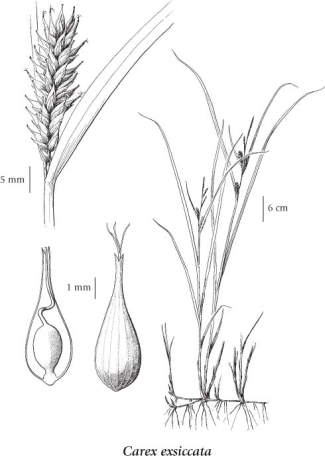Carex exsiccata L.H. Bailey
inflated sedge (western inflated sedge)
Cyperaceae (Sedge family)
Introduction to Vascular Plants
inflated sedge (western inflated sedge)
Cyperaceae (Sedge family)
Introduction to Vascular Plants
Species Information
General:
Perennial, tufted herb from short-creeping rhizomes; stems 30-100 cm tall, triangular, rough below the inflorescence, longer than the leaves.
Leaves:
Sheaths tight, ligules longer than wide; blades 4 to 8 per stem, flat, cross-walled, the margins rolled-under, borne on the lower 1/2 of the stem, 2-6 mm wide, the lower ones reduced, persistent.
Flowers:
Spikes 4 to 7, the terminal 2 or 3 linear, 1.5-5 cm long, long-stalked, with male flowers, the lower spikes 2 to 4, cylindrical, 2.5-7.5 cm long, with female flowers, or some with male flowers above the female flowers, short-stalked, erect to spreading, well spaced along the upper 1/2 of the stem; bracts subtending the lowest spike leaflike, sheathless, the lowest ones longer than the inflorescence.
Fruits:
Perigynia lanceolate, 7-10 mm long, 1.5-3 mm wide, yellowish-green to reddish- brown, somewhat inflated, smooth, shiny, strongly nerved, gradually tapered from the broad bases to long beaks, the beaks 1.5-3 mm long, bidentate, with straight teeth; female scales lanceolate to egg-shaped, pointed, narrower and shorter than the perigynia, yellowish- to reddish-brown, with 3-nerved, lighter centres and narrow, translucent margins; stigmas 3; achenes 3-angled, 1.7-2.4 mm long.
Notes:
Closely related to C. vesicaria.
Illustration

If more than one illustration is available for a species (e.g., separate illustrations were provided for two subspecies) then links to the separate images will be provided below. Note that individual subspecies or varietal illustrations are not always available.
Illustration Source: The Illustrated Flora of British Columbia
Ecology
Ecological Framework for Carex exsiccata
The table below shows the species-specific information calculated from
original data (BEC database) provided by the BC Ministry of Forests and Range.
(Updated August, 2013)
The table below shows the species-specific information calculated from
original data (BEC database) provided by the BC Ministry of Forests and Range.
(Updated August, 2013)
| Site Information |
Value / Class |
||
|
Avg |
Min |
Max |
|
| Elevation
(metres) |
1058 | 100 | 1890 |
| Slope
Gradient (%) |
0 | 0 | 10 |
|
Aspect (degrees) |
0 | 50 | 360 |
| Soil
Moisture Regime (SMR) [0 - very xeric; 4 - mesic; 8 - hydric] |
6 | 3 | 8 |
| Modal
Nutrient Regime
Class |
D | ||
| #
of field plots species was recorded in: |
135 | ||
| Modal
BEC Zone Class |
CWH | ||
|
All BEC Zones (# of stations/zone) species was recorded in |
BAFA(1), BG(1), BWBS(5), CDF(6), CWH(44), ESSF(16), ICH(20), IDF(4), MS(26), SBPS(9), SBS(3) | ||
|
Source:
Klinkenberg 2013
|
|||
Habitat and Range
Fens, swamps, marshes, shorelines and wet meadows in the lowland and montane zones; common in SW BC, less frequent northward; N to AK and NT, disjunct E to SK and S to CO, UT, NV and CA.Status Information
Synonyms
Synonyms and Alternate Names:
Carex vesicaria var. major Boott